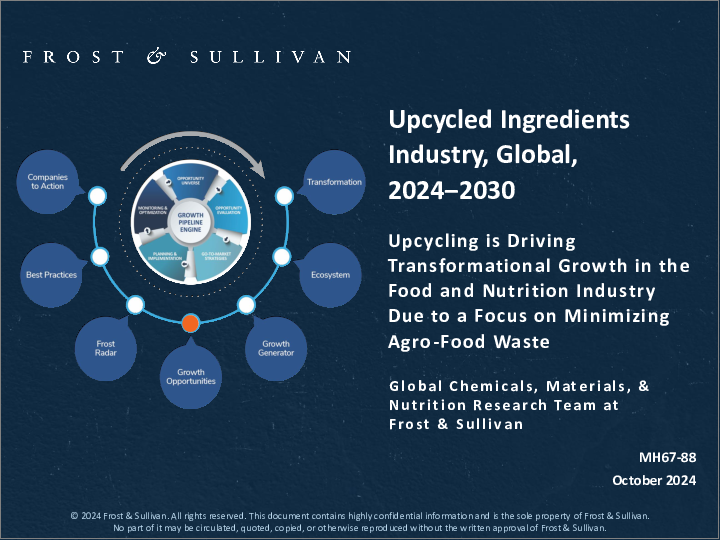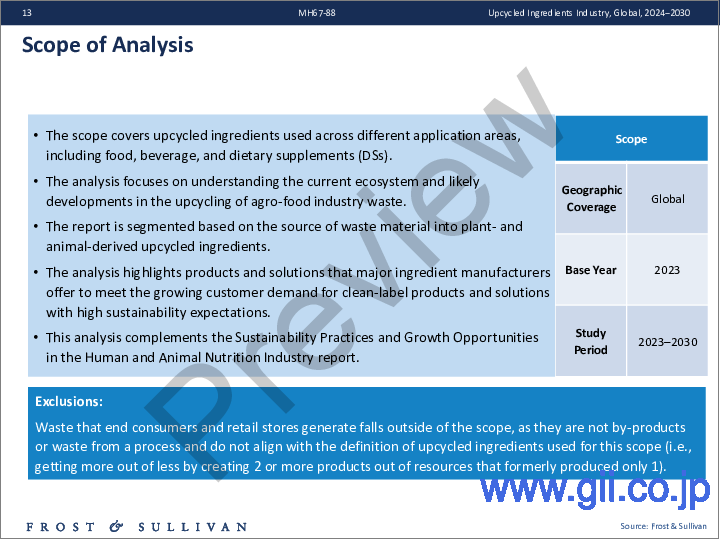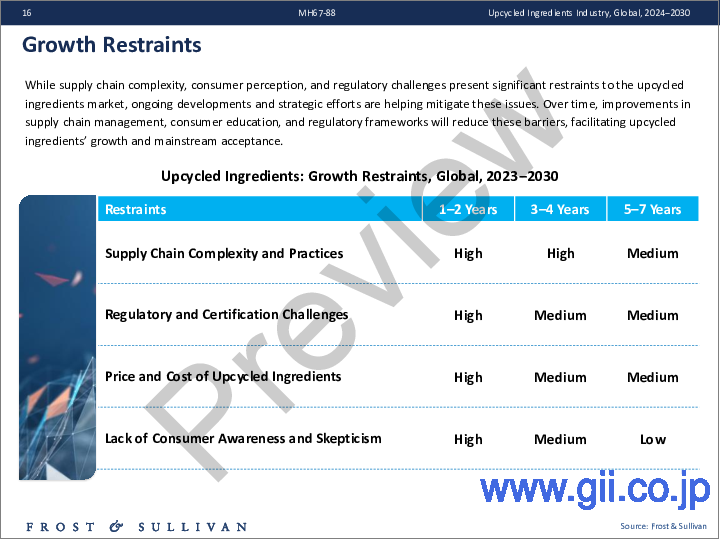|
|
市場調査レポート
商品コード
1586736
アップサイクル原料産業:世界、2024年~2030年Upcycled Ingredients Industry, Global, 2024-2030 |
||||||
|
|||||||
| アップサイクル原料産業:世界、2024年~2030年 |
|
出版日: 2024年10月17日
発行: Frost & Sullivan
ページ情報: 英文 118 Pages
納期: 即日から翌営業日
|
- 全表示
- 概要
- 目次
アップサイクルは、農業食品廃棄物の最小化に重点を置くことにより、食品および栄養産業における変革的成長を牽引しています。
アップサイクル原料とは、農産物・食品産業のバリューチェーンに沿ったプロセスから得られる製品別の価値化によって生産される原料のことで、新製品の一部として食品バリューチェーンに再び参入することができます。実際には、食品システムは、以前は1つしか生産できなかった資源から2つ以上の製品を生み出すことで、「より少ないもの」から「より多くのもの」を得ることができます。アップサイクルは、価値を生み出す廃棄物管理戦略です。これは、環境問題に取り組み、食品産業における持続可能性を促進する、より広範な動きの一部です。調査対象は、食品、飲料、栄養補助食品など、さまざまな応用分野で使用されるアップサイクル原料です。分析では、農業食品産業廃棄物のアップサイクルにおける現在のエコシステムと予想される展開の理解に重点を置いています。本レポートは、廃棄物の発生源に基づいて、植物由来と動物由来のアップサイクル原料に区分しています。分析では、クリーンラベル製品や高い持続可能性を期待するソリューションに対する顧客需要の高まりに対応するため、主な原料メーカーが提供する製品やソリューションにハイライトを当てています。対象範囲は、食品と栄養分野で活動し、アップサイクル原料を使用または生産している企業です。
主な競合企業
- Apparo
- Arla Food Ingredients
- Barry Callebaut Group
- BASF
- BLUE STRIPES
- Brightseed
- Cargill
- Clariant
- COMET-Bio
- CP Kelco
- Crush Dynamics Inc.
- Del Monte Foods, Inc.
- dsm-firmenich
- Extracta
- Fancypants Bakery
- Flavor Producers, LLC
- Friesland Campina
- Givaudan
- Glanbia Nutritionals
- GoodSport Nutrition
- Harmless Harvest
- IFF
- Ingredion
- Kemin Industries
- Kerr by Ingredion
- Kerry Ingredients
- NETZRO
- NURA USA LLC
- NutriLeads
- Outcast
- PURIS
- ReBon
- ReGrained
- Renewal Mill
- Roquette
- Tate & Lyle
- The Coffee Cherry Co.(formerly Coffee Flour)
- Upcycled Food, Inc.
アップサイクル原料業界における戦略的課題トップ3の影響:
社内の課題
要因
- 廃棄物の処理にはコストがかかり、多額の資本投資が必要であるため、資源を圧迫する可能性があります。
- 持続可能性のイニシアチブを取り入れるには、社内のプロセスを大きく変える必要があり、これは従業員や上層部にとって困難な課題となりえます。
フロストの視点
- 高度なデジタル技術の採用は、予測期間中に企業の導入課題を克服すると思われます。
- 例えば、高度なAI技術の利用は、アップサイクルを目的とした食品廃棄物の識別と利用を最適化することができ、アップサイクル施設にロボット工学を統合することは、資源効率を改善し、コストを削減することができます。
- 企業は、アップサイクルの取り組みを確実に成功させるために、ビジョンと目標を一致させ、研究開発に投資しなければなりません。
変革のメガトレンド
要因
- 持続可能で環境に優しい食品素材と製品に対する消費者の意識と需要は高まっています。
- 需要の高まりにもかかわらず、アップサイクル原料は廃棄物から作られているため、一部の顧客は躊躇しています。
- アップサイクル原料に関する統一された規制が存在しないため、消費者を混乱させています。
フロストの視点
- 企業は誤解に対処するため、マーケティングと消費者教育プログラムに投資しなければなりません。明確で透明性のある表示の遵守と製品認証の取得は、市場への浸透を促進します。
- アップサイクル食品協会(UFA)のような団体と協力してアップサイクル原料の利点に対する認識を高めることが需要を促進します。
- 利害関係者が協力して規制の調和を図り、業界の成長を支援する必要があります。
競合の激しさ
要因
- バリューチェーン参加者の間でアップサイクルへの注目が高まるにつれて、競合の激しさは予測期間中に増大します。
- 大手原料サプライヤーは、ユニークな原料やソリューションを提供するニッチ企業との競合が激しくなります。
フロストの視点
- 競争上の差別化を維持するために、企業は研究開発への投資を増やし、独自のソリューションを提供するか、ニッチな新興企業との協力やパートナーシップを形成して競争力を維持する必要があります。
セグメンテーション
アップサイクル原料
アップサイクル原料:原料別
植物由来
- 果物
- 野菜
- 穀類
- 豆類
- ナッツ・種子
動物由来
- 肉類
- 魚介類
- 乳製品
- 酪農
アップサイクル原料:用途別
- 栄養補助食品
- 食品・飲料
主な競合製品
ADM
ADMは、穀物、油糧種子、トウモロコシなどの農産物を必須食品原料、動物飼料、再生可能燃料、持続可能な製品に変換する、農業加工と食品原料製造の大手企業です。同社はアップサイクル甘味料、澱粉、栄養成分を生産し、革新的な製品を提供しています。
- アップサイクルされた果糖ぶどう糖液糖(HFCS)廃棄物:ADMは、トウモロコシを加工して、食品・飲料業界で広く使用されている甘味料であるHFCSを製造しています。主な製品はHFCSであるが、ADM社は、トウモロコシの繊維や胚芽などの他の貴重な成分を抽出し、それぞれ食物繊維と油に加工することで、トウモロコシを最大限に利用しています。
- コーンスターチ廃棄物のアップサイクルADM社は、トウモロコシを食品、製紙、工業用途に使用される様々なデンプン製品に加工し、胚芽からコーン油を抽出しています。
Cargill
- Cargillは米国最大の非上場企業の一つで、農産物の取引、加工、流通に大きく関わっています。同社は穀物(トウモロコシ、小麦、大豆)や油糧種子など幅広い作物を扱っています。
- 同社は、廃棄物の有価化における数々のイニシアチブのほか、持続可能な調達、透明性とトレーサビリティ、廃棄物の削減、アップサイクルといった分野にわたって、繊維の持続可能性に力を入れている:
- CitriPure(R)シトラス繊維は、柑橘類の果皮を化学薬品を使わずに加工したものです。果実の他の部分はジュースやオイルに使用されるため、生産工程でほとんど無駄なく果実全体が使用されます。
- 2019年、CargillとRenmatixは植物素材を機能性食品素材にアップサイクルするための新たなアプローチを共同で探求する計画を発表しました。RenmatixのPlantrose Process技術とCargillが推奨する原料は、乳化剤とハイドロコロイドの代替品を開発しました。Renmatix社は、パン職人、シェフ、食品メーカーが卵の代替、保存期間の延長、油脂の削減、ラベルのクリーン化に使用する、多用途でクリーンラベルの食品素材であるNouravant(R)メープルファイバーを開発しました。
Chiquita
- Chiquitaはラテンアメリカで幅広く事業を展開しています。
- 同社はバナナの非食用部分を再利用し、土壌を覆って保護し、水分を保持するのに役立っています。これらの植物の残骸は優れた天然の肥料となります。動物、昆虫、カエルなど地元の野生動物は、堆肥溝で餌をとることで恩恵を受け、生物多様性を促進しています。コスタリカでは、ダイジェスターシステムが植物原料を再生可能エネルギーに変換し、施設の電力源としています。
- Chiquitaは、パナマとコスタリカからの年間約6万5,000トンのバナナを扱うコスタリカ工場で、不完全なバナナ(いわゆる醜いバナナ)をピューレに加工しています。ピューレに使用しない場合は、バナナ粉に加工します。チキータは傷ついたバナナを無駄にせず、家畜の餌として地元の農家に分配しています。
Del Monte Foods
- Del Monte Foodsの2023年サステナビリティレポートでは、2025年までに食品廃棄物をアップサイクルし、すべての食品が最高の目的に到達できるようにすることを目標のひとつに掲げています。
- 2023年、同社はUFAを通じて300万ポンド以上の余剰食品をアップサイクルしました。
Fyffes
- ダブリンのバルブリガンにある熟成センターから、毎月最大2トンの完熟バナナをジゼルマキンデの企業、Cream of the Cropに寄付しています。
- Cream of the Cropは、農家や生産者、食品生産者から仕入れた余剰食材から作られる手作りジェラートを専門としています。
目次
戦略的課題
- なぜ成長が難しくなっているのか?
- The Strategic Imperative 8(TM)
- アップサイクル素材産業における戦略的重要課題トップ3のインパクト
- 成長機会がGrowth Pipeline Engine(TM)を後押しする
成長機会分析
- 略語
- 分析範囲
- セグメンテーション
- 定義
- アップサイクル原料とは何か?
- 持続可能な食品生産の文脈におけるアップサイクル原料
- アップサイクル原料概要
- なぜアップサイクルなのか?
- 食品製造バリューチェーンにおける廃棄物の発生源
- 植物性廃棄物と動物性廃棄物:健康リスク、規制アプローチ、経済的影響
- 農産物廃棄物の負担
- アップサイクル認証(TM)基準
- アップサイクル認証(TM)基準:定義と要素
- 主な競合企業
- アップサイクル認証(TM)原料を使用する企業の例
- 促進要因
- 促進要因分析
- 成長抑制要因
- 成長抑制要因分析
- 主要動向スポットライト
- 主要動向分析
植物由来のアップサイクル原料の成長機会分析
- 食品製造バリューチェーンにおける植物由来の廃棄物の供給源
- カテゴリー別の生産量上位10作物
- 廃棄物量に基づく上位供給源
- 上位廃棄物発生源からのアップサイクルの可能性とアップサイクル原料
- 製造および加工から出る植物由来の廃棄物
- 果実および野菜廃棄物の製造・加工からのアップサイクル原料の可能性
- ナッツ廃棄物の製造・加工からのアップサイクル原料の可能性
- 種子廃棄物の製造・加工からのアップサイクル原料の可能性
- 穀物・豆類廃棄物の製造・加工からのアップサイクル原料の可能性
- 主な競合企業のアップサイクル慣行
- 主要競合企業の製品
- 他のバリューチェーン参加企業による取り組み
- ケーススタディ:ビール製造廃棄物のアップサイクル
- ケーススタディ:ワイン製造廃棄物のアップサイクル
動物由来のアップサイクル原料の成長機会分析
- 食品製造バリューチェーンにおける動物性廃棄物の発生源
- アップサイクルの可能性がある乳製品加工からの廃棄物
- アップサイクルの可能性と乳製品加工廃棄物からのアップサイクル原料
- ホエーの主な産業用途と機能特性
- 乳製品加工廃棄物からのアップサイクルの可能性とアップサイクル成分
- 乳製品廃棄物からのアップサイクル成分を含む市販製品
- アップサイクルの可能性を持つ卵産業からの廃棄物
- 卵加工廃棄物からのアップサイクルの可能性とアップサイクル成分
- 卵廃棄物からのアップサイクル成分を含む商業製品
- 廃棄物の有効利用:食肉業界の概要
- アップサイクル可能な食肉産業廃棄物
- 畜産廃棄物からのアップサイクル原料
- 動物性廃棄物からのアップサイクル成分を含む商業製品
- ケーススタディ:Thai Union Ingredient(TUI)の廃棄物の最適化
成長機会領域
- 成長機会1:高度加工技術の開発
- 成長機会2:持続可能なサプライチェーンと調達管理
- 成長機会3:様々な原料やサイドストリームを評価する用途の多様化
付録と次のステップ
- 成長機会の恩恵と影響
- 次のステップ
- 別紙リスト
- 免責事項
Upcycling is Driving Transformational Growth in the Food and Nutrition Industry Due to a Focus on Minimizing Agro-Food Waste
An upcycled ingredient is an ingredient produced by the valorization of byproducts obtained from processes along the agro-food industry value chain that can re-enter the food value chain as part of a new product. In practice, the food system can get "more" out of "less" by creating two or more products out of resources that formerly produced only one. Upcycling is a waste management strategy that creates value. It is part of a broader movement to address environmental concerns and promote sustainability within the food industry. The research scope covers upcycled ingredients used across different application areas, including food, beverage, and dietary supplements. The analysis focuses on understanding the current ecosystem and likely developments in the upcycling of agro-food industry waste. The report is segmented based on the source of waste material into plant- and animal-derived upcycled ingredients. The analysis highlights products and solutions that key ingredient manufacturers offer to meet the growing customer demand for clean-label products and solutions with high sustainability expectations. The companies considered in the scope are those active in the food and nutrition space and use or produce upcycled ingredients.
Key Competitors:
- Apparo
- Arla Food Ingredients
- Barry Callebaut Group
- BASF
- BLUE STRIPES
- Brightseed
- Cargill
- Clariant
- COMET-Bio
- CP Kelco
- Crush Dynamics Inc.
- Del Monte Foods, Inc.
- dsm-firmenich
- Extracta
- Fancypants Bakery
- Flavor Producers, LLC
- FrieslandCampina
- Givaudan
- Glanbia Nutritionals
- GoodSport Nutrition
- Harmless Harvest
- IFF
- Ingredion
- Kemin Industries
- Kerr by Ingredion
- Kerry Ingredients
- NETZRO
- NURA USA LLC
- NutriLeads
- Outcast
- PURIS
- ReBon
- ReGrained
- Renewal Mill
- Roquette
- Tate & Lyle
- The Coffee Cherry Co (formerly Coffee Flour)
- Upcycled Food, Inc.
The Impact of the Top 3 Strategic Imperatives on the Upcycled Ingredients Industry:
Internal Challenges
WHY
- Processing waste material is costly and requires significant capital investments, which can strain resources, especially when such sustainability initiatives are not part of a company’s core strategy.
- The incorporation of sustainability initiatives requires a significant change in internal processes, which could be challenging for employees and higher management.
FROST PERSPECTIVE
- The adoption of advanced digital technologies will overcome companies’ implementation challenges during the forecast period.
- For instance, the use of advanced AI technologies can optimize food waste identification and utilization for upcycling purposes, and the integration of robotics in upcycling facilities can improve resource efficiency and reduce costs.
- Companies must align their vision and goals and invest in R&D to ensure the success of upcycling initiatives.
Transformative Megatrends
WHY
- Consumer awareness and demand for sustainable, environmentally friendly food ingredients and products is growing.
- Despite growing demand, some customers remain hesitant when it comes to upcycled ingredients because they are made of waste materials.
- The growing focus on safety and quality is increasing, as no harmonized regulations for upcycled ingredients exist, which confuses consumers.
FROST PERSPECTIVE
- Companies must invest in marketing and consumer education programs to address misconceptions. Adhering to clear and transparent labeling and gaining product certifications will drive market penetration.
- Collaborating with associations such as the Upcycled Food Association (UFA) to increase awareness of the benefits of upcycled ingredients will drive demand.
- Stakeholders need to work together to achieve regulatory harmonization to support industry growth.
Competitive Intensity
WHY
- The competitive intensity will increase during the forecast period as the focus on upcycling expands among value chain participants.
- Large ingredient suppliers will see strong competition from niche players offering unique ingredients and solutions.
FROST PERSPECTIVE
- To maintain competitive differentiation, companies must invest more in R&D and offer unique solutions or collaborate and form partnerships with niche start-ups to maintain their competitive edge.- In an upcycled industry, establishing solid partnerships with raw material suppliers will remain essential to maintaining a strong market position.
Segmentation
Upcycled Ingredients
Upcycled Ingredients by Source
Plant-based
- Fruits
- Vegetables
- Grains
- Legumes
- Nuts and seeds
Animal-based
- Meat
- Fish and seafood
- Dairy products
- Dairies
Upcycled Ingredients by Application
- Dietary Supplements
- Food & Beverages
Key Competitor Offerings:
ADM
ADM is a major player in agricultural processing and food ingredient production, converting agricultural commodities such as grains, oilseeds, and corn into essential food ingredients, animal feeds, renewable fuels, and sustainable products. The company produces and innovates with upcycled sweeteners, starches, and nutritional ingredients.
- Upcycled high fructose corn syrup (HFCS) waste: ADM processes corn into HFCS, a widely used sweetener in the F&B industry. While the primary product is HFCS, ADM maximizes corn use by extracting other valuable components, including corn fibers and corn germ, that it processes into dietary fiber and oil, respectively.
- Upcycled corn starch waste: ADM processes corn into various starch products used in food, paper, and industrial applications and extracts corn oil from the germ.
Cargill
- Cargill is one of the largest privately held corporations in the United States and is heavily involved in agricultural commodity trading, processing, and distribution. The company deals with a wide range of crops, including grains (corn, wheat, and soybeans) and oilseeds.
- Aside from the company’s numerous initiatives in waste valorization, it has put effort into fiber sustainability across areas such as sustainable sourcing, transparency and traceability, waste reduction, and upcycling:
- CitriPure® citrus fiber is made of citrus fruit peel using chemical-free processing. Other parts of the fruit are used for juice and oil, so the whole fruit is used with little to no waste in the production process.
- In 2019, Cargill and Renmatix announced plans to jointly explore new approaches for upcycling plant materials into functional food ingredients. Renmatix Plantrose Process technology and Cargill's preferred feedstocks developed alternatives for emulsifiers and hydrocolloids. Renmatix created Nouravant® maple fiber, a versatile, clean-label food ingredient that bakers, chefs, and food manufacturers use to replace eggs, extend shelf life, reduce fats, and clean up labels.
Chiquita
- Chiquita has extensive operations in Latin America.
- On the farm, nothing goes to waste—the company repurposes the non-edible parts of banana plants to cover and protect the soil, helping retain moisture. These plant remains serve as an excellent natural fertilizer. Local wildlife, including animals, insects, and frogs, benefit from feeding in the compost trenches, which promotes biodiversity. In Costa Rica, a digester system transforms plant material into renewable energy to power the facility.
- Chiquita processes imperfect bananas (so-called ugly bananas) into purée at its Costa Rican plants, which handle about 65,000 tons of bananas annually from Panama and Costa Rica. If the company does not use the fruit for purée, it converts it into banana flour. Chiquita does not waste bruised bananas but distributes them to local farmers to feed livestock.
Del Monte Foods:
- In Del Monte Foods’ 2023 Sustainability report, the company stated that, by 2025, one of its goals would be to upcycle food waste to ensure all food reaches its highest purpose.
- In 2023, the company upcycled more than 3 million pounds of surplus food through the UFA.
Fyffes:
- Each month, Fyffes donates up to 2 tons of ripe bananas that only qualify as surplus because they do not meet supermarkets’ specification criteria, from its ripening center in Balbriggan, Dublin, to Giselle Makinde’s enterprise, Cream of the Crop.
- Cream of the Crop specializes in Artisan Gelatos, which are made from surplus food ingredients that the company sources from farmers, growers, and food producers.
Table of Contents
Strategic Imperatives
- Why Is It Increasingly Difficult to Grow?
- The Strategic Imperative 8™
- The Impact of the Top 3 Strategic Imperatives on the Upcycled Ingredients Industry
- Growth Opportunities Fuel the Growth Pipeline Engine™
Growth Opportunity Analysis
- Abbreviations
- Scope of Analysis
- Segmentation
- Definitions
- What is an Upcycled Ingredient?
- Upcycled Ingredients in the Context of Sustainable Food Production
- Upcycled Ingredients: An Overview
- Why Upcycling?
- Sources of Waste in the Food Manufacturing Value Chain
- Plant vs Animal Waste: Health Risks, Regulatory Approaches, and Economic Impacts
- Agrifood Waste Burden
- The Upcycled Certified™ Standard
- The Upcycled Certified™ Standard: Definition and Elements
- Key Competitors
- Examples of Companies with Upcycled Certified™ Ingredients
- Growth Drivers
- Growth Driver Analysis
- Growth Restraints
- Growth Restraint Analysis
- Top Trends Spotlight
- Top Trends Analysis
Growth Opportunity Analysis for Plant-based Upcycled Ingredients
- Sources of Plant-based Waste in the Food Manufacturing Value Chain
- Top 10 Crops by Production Volume Across Categories
- Top Sources Based on Waste Volume
- Upcycling Potential and Upcycled Ingredients from Top Waste-producing Sources
- Plant-based Waste from Manufacturing and Processing
- Potential Upcycled Ingredients from the Manufacturing and Processing of Fruit and Vegetable Waste
- Potential Upcycled Ingredients from the Manufacturing and Processing of Nut Waste
- Potential Upcycled Ingredients from the Manufacturing and Processing of Seed Waste
- Potential Upcycled Ingredients from the Manufacturing and Processing of Grain and Legume Waste
- Upcycling Practices of Main Competitors
- Key Competitor Offerings
- Initiatives by Other Value Chain Participants
- Case Study: Upcycling Waste from Beer Manufacturing
- Case Study: Upcycling Waste from Wine Manufacturing
Growth Opportunity Analysis for Animal-based Upcycled Ingredients
- Sources of Animal-based Waste in the Food Manufacturing Value Chain
- Waste from Dairy Processing with Upcycling Potential
- Upcycling Potential and Upcycled Ingredients from Dairy Processing Waste
- Main Industrial Application of Whey and Functional Characteristics
- Upcycling Potential and Upcycled Ingredients from Dairy Processing Waste
- Commercial Products Containing Upcycled Ingredients from Dairy Waste
- Waste from the Egg Industry with Upcycling Potential
- Upcycling Potential and Upcycled Ingredients from Egg Processing Waste
- Commercial Products Containing Upcycled Ingredients from Egg Waste
- Waste Valorization: Meat ndustry Overview
- Waste from the Meat Industry with Upcycling Potential
- Upcycled Ingredients from Animal Processing Waste
- Commercial Products Containing Upcycled Ingredients from Animal Waste
- Case Study: Thai Union Ingredient (TUI) Waste Optimization
Growth Opportunity Universe
- Growth Opportunity 1: Development of Advanced Processing Technologies
- Growth Opportunity 2: Sustainable Supply Chain and Sourcing Management
- Growth Opportunity 3: Application Diversification in Valorizing Different Ingredients and Side Streams
Appendix & Next Steps
- Benefits and Impacts of Growth Opportunities
- Next Steps
- List of Exhibits
- Legal Disclaimer






